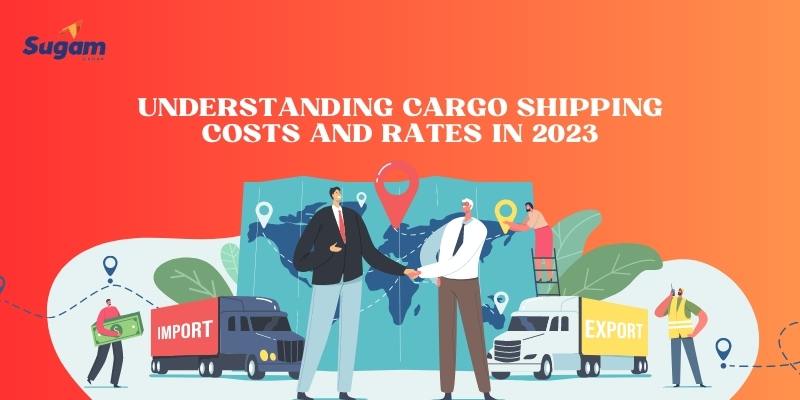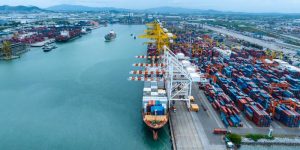Understanding Cargo Shipping Costs and Rates in 2023
In the dynamic world of international trade, understanding cargo shipping costs and rates in 2023 is crucial for businesses seeking efficient and cost-effective transportation solutions. This blog aims to provide insights into various factors that impact shipping costs, such as the choice of cargo services, additional charges, and strategies for reducing expenses. By gaining a comprehensive understanding of these aspects, businesses can make informed decisions, optimize their logistics operations, and navigate the ever-changing landscape of cargo shipping in the year 2023. Let’s start with how container shipping costs are calculated.
How are Container Shipping Costs Calculated?
Container shipping is the most common way to transport goods internationally, and it’s essential to know how to calculate the costs involved. The cost of container shipping is determined by several factors, including the volume and weight of the cargo, the distance between the origin and destination ports, and the shipping method chosen. Let’s explore each one of them.
- Volume and Weight of the Cargo
The volume and weight of the cargo being shipped are the most significant factors in determining the cost of container shipping. Shipping rates are typically calculated based on the weight of the cargo, with higher rates charged for heavier cargo. Shipping companies also charge based on the volume of the cargo, with more substantial cargo taking up more space in the container, resulting in higher shipping costs.
- Distance Between Ports
The distance between the ports of origin and destination is another crucial factor in determining the cost of container shipping. Longer distances generally mean higher shipping costs, as more fuel is required to transport the cargo.
- Shipping Method
The shipping method chosen can also impact the cost of container shipping. There are two main methods of container shipping: sea and air. Sea freight is generally less expensive than air freight, but it can take longer to transport the cargo.
- Additional Costs
In addition to the basic shipping costs, there are several additional costs to consider when calculating container shipping costs. These costs can include customs fees, port fees, insurance, and taxes.
- CIF and FOB
CIF (Cost, Insurance, and Freight) and FOB (Free on Board) are two common terms used in international container shipping. CIF refers to the total cost of the cargo, including insurance and freight charges, while FOB refers only to the cost of loading the cargo onto the ship. It’s essential to understand these terms when calculating container shipping costs.
Also Read:- How to save money on cargo services
Which Size Shipping Container Do I Need?
When it comes to international container shipping, choosing the right container size is important. You don’t want to pay for more space than you need, but you also don’t want to cram your belongings into a container that’s too small. Here are some common container sizes and their typical uses.
- 20-Foot Container
A 20-foot container is the smallest size you’ll typically see for international shipping. It’s suitable for small apartments or one or two rooms’ worth of belongings. A 20-foot container can hold around 10 to 12 standard pallets.
- 40-Foot Container
The 40-foot container is the most common size used for international shipping. It’s suitable for a two- to three-bedroom house or a vehicle. A 40-foot container can hold around 20 to 24 standard pallets.
- 40-Foot High Cube Container
The 40-foot high cube container is similar to the standard 40-foot container, but it’s taller, with an extra foot of height. This can be useful if you have bulky items that won’t fit in a standard container. A 40-foot high cube container can hold around 20 to 24 standard pallets.
- 45-Foot Container
The 45-foot container is less common, but it can be a good option if you have a lot of belongings or large items to ship. It’s suitable for a four- to five-bedroom house or a vehicle. A 45-foot container can hold around 28 to 30 standard pallets.
FCL vs LCL:
FCL (Full Container Load) and LCL (Less Than Container Load) are terms used in the shipping and logistics industry to describe different ways of transporting goods via sea freight.
- FCL refers to a situation where a shipper or consignee has enough goods to fill an entire shipping container. In FCL, the shipper pays for the use of the entire container, regardless of whether it is completely filled or not. The container is then sealed and transported as a single unit from the origin to the destination. FCL offers the advantage of exclusivity, as the entire container is dedicated to the shipper’s goods, minimizing the risk of damage and ensuring faster transit times.
- LCL, on the other hand, is used when a shipper’s goods do not occupy the entire capacity of a shipping container. In this case, the shipper shares the container space with other shippers who also have smaller loads. LCL consolidates multiple shipments into a single container, and the cost is divided among the different shippers based on the space they utilize. LCL is a cost-effective solution for smaller shipments, as shippers pay only for the space they need. However, the downside is that LCL shipments may experience longer transit times and a higher risk of damage due to the handling of multiple shipments within the container.
Why choose Full Container Load (FCL)?
Full Container Load (FCL) is a shipping option where shippers have enough goods to fill an entire shipping container. With FCL, the shipper enjoys exclusivity and faster transit times as the entire container is dedicated to their cargo, offering a secure and efficient means of transporting larger volumes of goods.
- Exclusivity: With FCL, the shipper has exclusive use of the entire container, reducing the risk of damage or loss associated with sharing space.
- Faster transit times: Since FCL containers are not opened or unpacked during transit, they can be transported directly from origin to destination, resulting in quicker delivery times.
- Reduced handling: FCL shipments require fewer handling processes compared to LCL, minimizing the risk of damage and ensuring better cargo integrity.
- Flexibility: FCL allows the shipper to load and secure their goods according to their specific requirements, without the need to accommodate other shipments.
Why choose Less Than Container Load (LCL)?
Less Than Container Load (LCL) is a shipping option that allows shippers with smaller cargo volumes to share container space, reducing costs by paying only for the space they require, making it an economical solution for shipping smaller shipments without filling an entire container.
- Cost-effectiveness: LCL is a cost-efficient option for shippers with smaller shipments as they only pay for the space they utilize within the shared container.
- Consolidation: LCL enables multiple small shipments to be combined into a single container, optimizing the use of container space and reducing overall shipping costs.
- Accessibility: LCL provides access to sea freight services even for shippers with lower volume shipments who may not require a full container.
- Flexibility: Shippers can benefit from flexible scheduling options as LCL shipments are more frequent compared to FCL, offering greater availability.
Choice of Cargo Services
When it comes to transporting goods, businesses have several Freight transport options to choose from, including sea freight, air freight, truck freight, and train freight. Each mode of transport offers distinct advantages based on factors like cost, speed, and specific shipping requirements. By understanding the choices available, businesses can make informed decisions to ensure efficient and reliable transportation of their cargo.
What is Sea freight?
Sea freight refers to the transportation of goods by sea using ships or vessels. It involves the movement of large volumes of cargo over long distances, either in standard shipping containers or as non-containerized shipments. Sea freight is a cost-effective option for businesses as the sea freight charges are low and have less time-sensitive shipments and want to transport bulky or heavy goods.
Why choose sea freight?
Sea freight is chosen for several reasons. Firstly, it is cost-effective for transporting large volumes of goods over long distances. Secondly, it accommodates a wide range of cargo types, including both containerized and non-containerized shipments. Lastly, sea freight is suitable for businesses with flexible delivery timelines and who prioritize cost-efficiency over faster transit times.
What is Air freight?
Air freight involves the transportation of goods by air using cargo planes. It is the fastest mode of transport for international shipments, providing quick delivery to various global destinations. Air freight is commonly used for time-sensitive goods, perishable items, and high-value products that require swift and reliable transport. Here air freight charges are quite high that might not yield results for a small business.
Why choose Air freight?
Air freight is chosen for its speed and efficiency. It offers rapid delivery, reducing transit times significantly compared to other modes of transport. This makes it an ideal choice for businesses that prioritize time-sensitive shipments and need to meet tight deadlines. Additionally, air freight provides enhanced security measures and the ability to reach global destinations efficiently.
What is truck freight?
Truck freight involves the transportation of goods by trucks over land. It is a flexible and versatile option that provides door-to-door delivery for domestic or short-distance shipments. Truck freight is commonly used for small to medium-sized shipments, regional distribution, and just-in-time delivery. It offers faster transit times compared to other modes of transport and is suitable for industries that require frequent and flexible transportation services. The truck freight charges here are also quite affordable that ultimately leads to cost saving for businesses.
Why choose truck freight?
Truck freight is chosen for its flexibility and efficiency. It offers door-to-door delivery, providing convenience for businesses. The shorter transit times compared to other modes of transport make it suitable for time-sensitive shipments within a specific region or country. Moreover, truck freight is cost-effective for small to medium-sized shipments and provides the ability to schedule deliveries according to specific requirements.
What is Train freight?
Train freight, also known as rail freight, involves transporting goods by train. It is a reliable and cost-effective mode of transport, particularly for long-distance and large-scale cargo transportation. Train freight is commonly used for the movement of bulk commodities, such as minerals, grains, and heavy machinery, over extensive land routes. The train freight charges here are also favourable since bulk transportation occurs here.
Why choose train freight?
Train freight is chosen for its reliability and cost-effectiveness. It offers high load capacity, making it suitable for transporting large volumes of goods. Train freight also consumes less fuel compared to road transport, resulting in reduced emissions and environmental benefits. It is a preferred choice for industries that require long-distance transportation of bulk commodities or heavy goods.
Other Factors that Affect Shipping Costs:
These additional factors should be considered when calculating the total shipping costs for goods. It is crucial for businesses to account for these factors to ensure accurate budgeting and efficient management of their shipping operations.
-
Customs duties:
Customs duties are taxes imposed on goods when they cross international borders. These duties vary based on the country of import, the type of goods, and the applicable trade agreements or tariffs. Customs duties can significantly impact shipping costs, as importers are required to pay these fees to clear their goods through customs.
-
Container inspection fees:
Container inspection fees are charges incurred when containers are subjected to inspections by customs authorities or regulatory agencies. These inspections aim to ensure compliance with import/export regulations, safety standards, and to prevent the smuggling of prohibited items. Container inspection fees can increase shipping costs, particularly if the inspection process requires additional handling or delays.
-
General Rate Increase (GRI):
A General Rate Increase (GRI) is an adjustment made by shipping lines to increase freight rates across specific trade routes or regions. GRIs are typically implemented to offset rising operational costs, such as fuel prices or changes in market demand. GRIs can result in higher shipping costs for businesses, as freight rates are adjusted to reflect the increased operational expenses.
-
Inland delivery charges:
Inland delivery charges refer to the costs associated with transporting goods to and from the ports or terminals. These charges include transportation expenses incurred during the movement of cargo from the port to the final destination or from the origin to the port. Inland delivery charges can vary based on factors such as distance, road infrastructure, fuel prices, and local regulations.
-
Insurance:
Insurance is an important consideration in shipping, as it provides coverage for potential loss, damage, or theft of goods during transit. Shipping insurance premiums are influenced by various factors, including the type of goods, the mode of transport, the value of the cargo, the destination, and the insurance coverage chosen. Including insurance in the shipping process adds an additional cost to the overall shipping expenses.
-
Storage:
Storage charges can occur when goods are held at the port or terminal beyond a specified free storage period. These charges apply when the consignee or importer is unable to collect or clear the goods within the allowed time frame. Storage fees vary based on the duration of storage and the space occupied by the goods. Delayed collection or clearance can lead to increased storage costs, adding to the overall shipping expenses.
Tips for Reducing Shipping Costs:
By implementing these tips, businesses can effectively reduce shipping costs, improve overall logistics efficiency, and enhance their bottom line. It is important to assess individual shipping needs and work closely with shipping partners to find customized solutions for cost optimization.
-
Consolidation:
Consolidating shipments involves combining multiple smaller shipments into a single larger shipment. By consolidating shipments, businesses can benefit from economies of scale and reduce costs associated with handling, documentation, and transportation. This approach is particularly useful for smaller businesses or those with frequent smaller shipments.
-
Proper packaging:
Proper packaging is essential to avoid damage or loss during transit. By using appropriate packaging materials, ensuring proper cushioning, and securing goods, businesses can minimize the risk of damage and the need for additional packaging or repackaging. Properly packaged goods are less likely to incur extra fees or require re-shipment due to damages.
-
Negotiating rates:
Negotiating shipping rates with carriers and logistics providers can lead to cost savings. Businesses can explore options like long-term contracts, volume discounts, or negotiating lower rates based on shipment frequency or size. Building strong relationships with shipping partners and demonstrating a consistent shipping volume can provide leverage for better rates.
-
Timing:
Being mindful of timing can help reduce shipping costs. Planning shipments during off-peak periods or avoiding peak seasons and holidays can lead to lower rates. Additionally, optimizing lead times and coordinating with carriers to minimize transit times can help avoid expedited shipping costs.
Conclusion:
Understanding cargo shipping costs and rates in 2023 is crucial for businesses. By considering different modes of transport, managing additional charges, and implementing cost reduction strategies, businesses can optimize their shipping expenses. By staying informed about customs duties, container inspection fees, GRIs, inland delivery charges, insurance, and storage, businesses can accurately calculate costs. Implementing tips like consolidation, proper packaging, rate negotiations, and timing shipments strategically can further reduce costs. By staying updated and working closely with shipping partners, businesses can navigate the complex world of cargo shipping and enhance operational efficiency.
Why Choose Cargo Services From Sugam Group?
Being in the industry for 50 years, Sugam Group provides excellence in their logistics services with well established international boundaries of transportation & 3PL solutions across India, Nepal, Bhutan & Bangladesh.
With over 1 Lac customers annually, we have 1,00,000+ sq. ft. area of warehouse space and 250+ offices in SAARC region along with 500+ GPS enabled vehicles.
FAQs:
Q1: What are cargo charges in shipping?
A: Cargo charges in shipping refer to the fees associated with transporting goods from one location to another. These charges include freight rates, handling fees, customs duties, documentation fees, and any additional services or surcharges related to the shipment.
Q2: What is the cost of a 20ft shipping container?
A: The cost of a 20ft shipping container can vary depending on factors such as the condition (new or used), location, availability, and market conditions. On average, the cost of a new 20ft shipping container can range from $2,000 to $5,000, while used containers may be available at lower prices.
Q3: What is the cost of a 40ft shipping container?
A: The cost of a 40ft shipping container, similar to a 20ft container, can vary based on factors such as condition, location, availability, and market conditions. On average, the cost of a new 40ft shipping container can range from $3,000 to $7,000, while used containers may have lower price points.
Q4: How do you calculate cargo cost?
A: Cargo cost is typically calculated based on several factors, including the weight or volume of the cargo, the distance it needs to be transported, the mode of transport (sea, air, truck, train), any additional services required (insurance, packaging, customs clearance), and any applicable taxes or duties. To get an accurate calculation, it is advisable to consult with shipping companies or freight forwarders who can provide detailed quotes based on specific shipment requirements.
Q5: Should I use air freight or sea freight?
A: The choice between air freight and sea freight depends on various factors. Air freight is faster but generally more expensive, making it suitable for time-sensitive shipments or goods with high value. Sea freight is cost-effective for larger volumes and long-distance shipments, but transit times are longer. Consider the urgency of the shipment, budget constraints, nature of the goods, and specific requirements to determine the most suitable option for your needs. Consulting with logistics professionals can help in making an informed decision.









No Comments